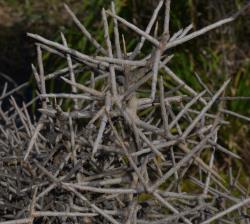- Taxon
- Gallery
Erect, ± evergreen shrubs up to 2.0 m tall, sometimes taller (Fig. 1). Exposed plants with compact, rigid, grey-brown crowns up to 1 m diam., composed of tightly divaricating branches (Fig. 2A) frequently smothered with lichens, bryophytes, and epiphytic ferns. Shaded plants with smaller, less divaricate, segmented crowns intermixed with those of other shrubs. Stems erect or suberect, 2—4 cm diam., knobbly and crooked with regular coppice and epicormic shoots and occasional layered stems. Outer bark greenish, grey, or brown, lenticellate, persistent; inner bark when exposed green. Branchlets at first slender, later stout, curved or straight, terete, finely pubescent at first, green, densely lenticellate, tapering to spinous tips; strongly interlaced on exposed plants with branch angles of 70-90°, less interlaced and more acute-angled on shaded plants (Fig. 3). Cotyledons 2,5—8 × 2—5 mm, broadly obovate, patent or deflexed, green, apex often retuse (Fig. 2F). Seedling and juvenile leaves alternate, 3-35 × 2-10 mm, shortly petiolate with petioles twisted through 45°, suberect or patent, at first small, ovate to lanceolate, incised or lobed, areolate, green, with finely revolute margins, later linear to linear-lanceolate with distinct irregular teeth or lobes, and brownish (Fig. 2E, F). Adult leaves alternate, 7-12 × 2 mm, solitary or in fascicles of 2(— 3), shortly petiolate or ± sessile, linear-oblong, often ± parallel-sided, entire or irregularly lobed, distinctly reflexed (Fig. 2B), thin, dark green above, paler beneath, glabrous when mature, minutely pubescent when young, margins finely revolute, apex retuse, often with a minute central apiculus. Flowers hermaphrodite, nectariferous, scented, perianth and androecium 5-merous, gynoecium 2-merous, solitary or more rarely paired, axillary, pendulous on lower side of branches. Peduncles slender, 0.5-2 mm long, decurved, green, with 2 minute, unequal, opposite, ovate, erose, orange bracteoles near the base, sometimes also at the middle. Flowers 2.5-3.5 mm diam.; sepals unequal, ovate to deltoid, 1.0—1.5 mm long, green suffused with red, with paler, membranous, erosulate-ciliate margins; petals ± fleshy, broadly oblong to cuneate, 3-4 × 2 mm, cream or yellow, with reflexed slightly thickened tips and erosulate-ciliate margins; anthers sessile, oblong, 0.5 mm long, 2-loculed, creamy yellow, with an extended, toothed, membranous, orange connective. Erect nectary appendage attached basally to the dorsal surface of each stamen, 0.5 mm long, cuneate, green. Anthers connate to form an urceolate tube surrounding the gynoecium. Ovary 1 mm long, ovoid, green; carpels 2; style slender, 0.5 mm long, not reaching corolla rim, 2-fid, green; stigma lobes flared, erosulate-papillate. Fruit a globose berry 4 - 5 mm diam. (Fig. 2C, D), white with scattered purple to black spots or patches; mesocarp purple-stained beneath spots, otherwise, white. Pyrenes usually 2, 3—4 mm long, plano-convex, purplish-brown; smaller berries with 1 ellipsoid pyrene with a median longitudinal furrow. Seed endospermous. FLOWERING: October to December. Flowering appears to be annual and regular in intensity, and the flowers are predominantly self-pollinating and apparently self-fertilised (see, however, below). Floral induction occurs in the summer preceding flowering, and new buds are visible in early autumn. FRUITING: March to May. Plants set abundant fruit which is probably dispersed by lizards (cf. Whitaker 1987), and possibly also by birds, but much falls directly beneath parent plants. Information on seed germination is lacking, although in other shrubby species of Melicytus studied, seeds germinate in the second spring following flowering (Molloy & Druce 1994; B. P. J. Molloy pers. obs.).
[Reproduced from Molloy & Clarkson (1996, New Zealand J. Bot. 34: 431–440) with permission from The Royal Society of New Zealand.]




